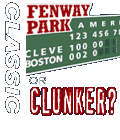|
|
|
|
 |
| ||
|
Scores Schedules Standings Statistics Transactions Injuries: AL | NL Players Weekly Lineup Message Board Minor Leagues MLB Stat Search MLB en espaņol Clubhouses | ||
| Sport Sections | ||
|
| ||
| Tuesday, November 7 | |||||
| Fenway Park timeline | |||||
| April 20, 1912: Boston defeats the New York Highlanders (now the Yankees), 7-6 in 11 innings, in the first official Red Sox game in Fenway. The game does not make the front page, however, due to the sinking of the Titanic the same day.
1915-1916: The Red Sox win back-to-back World Series, but play their home games at Braves Field, which has a larger capacity than Fenway. The Red Sox win the Series again in 1918 and play their home games at Fenway that year.
1919: After the 1919 season, Red Sox owner Harry Frazee sold Babe Ruth to the Yankees for $125,000. What is forgotten, however, is that Fenway Park was part of the deal. Frazee also collected a $350,000 loan for a mortgage on Fenway, meaning the Yankees owned the park until 1933. Not until Thomas Yawkey purchased the team in 1933 from Bob Quinn was the note paid in full.
May 8, 1926: The bleachers along the left-field wall burn down and are not replaced, vastly increasing the amount of foul territory behind third base.
April 28, 1929: The Red Sox play their first Sunday home game, a 7-3 loss to Philadelphia, at Commonwealth Park in Boston. Despite the fact that Sunday baseball was approved in Boston, the Sox are not allowed to play Sunday games at Fenway because of its proximity to a church.
1931: The Red Sox wear numbers on their uniforms.
July 3, 1932: The Red Sox play their first Sunday game at Fenway, a 13-2 loss to the Yankees, thanks to a change in the law restricting Sunday play at Fenway.
1934: New owner Yawkey spends a million dollars renovating the park. A New Year's fire at Fenway destroys most of the renovations being made, but the project is still completed. Yawkey replaces the wooden bleachers with concrete, extends the bleachers to the left-field wall, adds 6,000 grandstand seats, builds a press box (which lasts until 1989) ... and constructs a 37-foot high wall in left field. Essentially, this is the Fenway we know today.
April 17, 1934: The refurbished Fenway Park opens with a 6-5, 11-inning loss to the Washington Senators.
1936: A 23-foot tall screen is installed on top of the 37-foot high left-field wall to prevent broken windows on Lansdowne Street.
1940: New bullpens are constructed in front of the right-field bleachers, replacing the old bullpen areas in foul territory. The right-field stands are now 23 feet closer to home plate.
June 9, 1946: Ted Williams hits a 502-foot home run to right field off Detroit right-hander Fred Hutchinson. The ball lands on top of the straw hat worn by Joseph A. Boucher, who was sitting in section 42, row 37, seat 21. The seat is now painted red to commemorate the mammoth blast.
July 9, 1946: Ted Williams collects four hits (two singles, two home runs) and five RBI as the AL defeats the NL, 13-0, in the first All-Star-Game at Fenway Park. The game marks the return of the All-Star Game after a one-year hiatus due to war travel restrictions.
June 13, 1947: The Red Sox defeat the White Sox, 5-3, in the first night game at Fenway Park. Also on this day, green paint replaced the advertisements covering the left-field wall, giving birth to the "Green Monster."
May 12, 1948: WBZ-TV airs the first televised game from Fenway Park.
October 4, 1948: Cleveland beats the Red Sox, 8-3, in the first-ever single-game playoff in American League history. The loss prevents the Red Sox from joining the National League's Boston Braves in a cross-town World Series.
July 31, 1961: The second All-Star Game held at Fenway ends in a 1-1 tie after nine innings and a 30-minute rain delay.
1970: The center-field flag pole is removed from the outfield.
October 21, 1975: Carlton Fisk ends the first World Series night game at Fenway Park, which lasted 4:01, by hitting a leadoff homer in the bottom of the 12th inning, giving the Red Sox a 7-6 victory. Boston had tied the game on Bernie Carbo's three-run, pinch-hit home run with two outs in the eighth inning.
October 2, 1978: Fenway hosts the second one-game playoff in American League history, a 5-4 Red Sox loss to the New York Yankees and Bucky "#!*@*!" Dent.
1982-83: Private suites are built atop the stands in right field and left field.
1987-88: A color videoboard is installed in center field and the playing area is resodded.
1989: The old press box is torn down to make room for the 600 Club behind home plate, with the new press box built above the 600 Club section.
1992: The metal awning roof is constructed over the left field and right field roof box seats.
July 13, 1999: Fenway hosts the 70th Major League All-Star Game, an event that included the presentation of MLB's All-Century Team. The highlight of the presentation was the introduction of Ted Williams and the gathering around Williams at the pitchers' mound by the coaches and players on the field. | ALSO SEE Clunker Classic  | ||||
